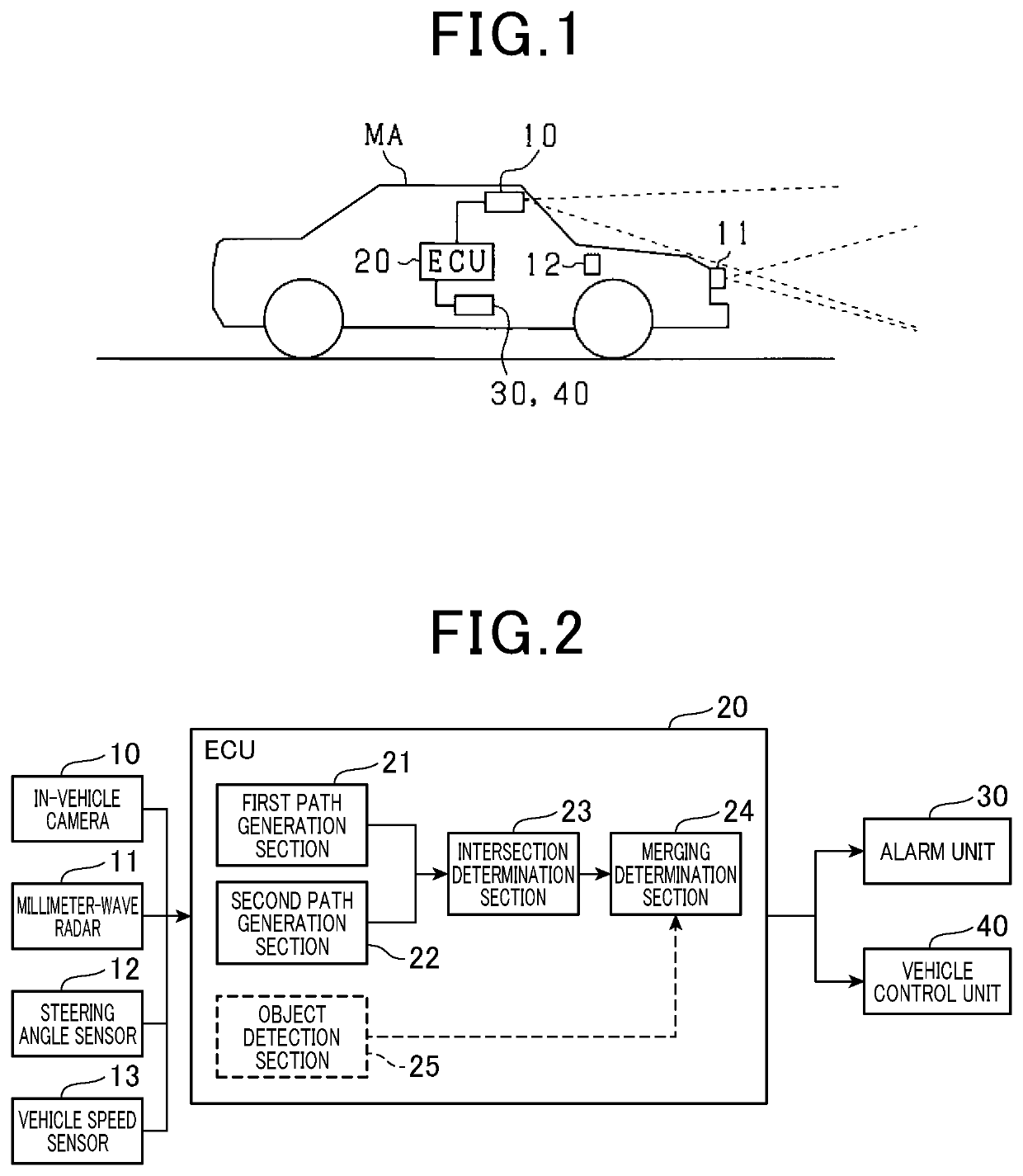Lane merging determination apparatus
a technology of determination apparatus and lane, which is applied in the field of lane merging determination apparatus, can solve the problem that the driving support apparatus cannot determine the merging of lanes
- Summary
- Abstract
- Description
- Claims
- Application Information
AI Technical Summary
Benefits of technology
Problems solved by technology
Method used
Image
Examples
first embodiment
[0019]The schematic configuration of the lane merging determination apparatus according to the first embodiment is described with reference to FIG. 1 and FIG. 2. The lane merging determination apparatus is configured by an ECU (electronic control unit) 20. The ECU 20 is a computer including a CPU, a ROM, a RAM, and an I / O. When the ECU 20 determines that lanes merge with each other based on information received from an in-vehicle camera 10, a millimeter-wave radar 11, a steering angle sensor 12, and a vehicle speed sensor 13, the ECU 20 transmits a merging signal to an alarm unit 30 and a vehicle control unit 40.
[0020]The in-vehicle camera 10 is a monocular camera configured by a CCD image sensor, a CMOS image sensor, a near-infrared sensor, or the like, or a stereo camera. The in-vehicle camera 10 captures images of the peripheral environment of the own vehicle MA to successively transmit image information of the captured images to the ECU 20. As shown in FIG. 1, the in-vehicle cam...
second embodiment
[0052]A lane merging determination apparatus according to the second embodiment is described with reference to FIG. 2 and FIG. 9 focusing on the differences from the lane merging determination apparatus according to the first embodiment.
[0053]When the own vehicle MA or the adjacent vehicle MB makes a lane change, the predicted path of the own vehicle MA and the adjacent path intersect with each other even when the roads are not joined to each other. When a lane change is made, no trouble is likely to occur even if it is determined that lanes merge with each other. However, it is desirable to determine joining of the roads with distinguishing this from a lane change. Hence, in the present embodiment, to determine joining of the roads with distinguishing this from a lane change, conditions for determining merging of lanes are added. In the present embodiment, not lanes such as a main line and a branch line but similar lanes are assumed to be merged with each other.
[0054]When lanes tha...
third embodiment
[0059]A lane merging determination apparatus according to the third embodiment is described with reference to FIG. 2 and FIG. 10 focusing on the differences from the lane merging determination apparatus according to the second embodiment. In the third embodiment, a case is assumed where a main line and a branch line merge with each other.
[0060]When a main line and a branch line merge with each other, the speed of a vehicle running in the main line is generally higher than the speed of the vehicle running in the branch line. In contrast, when a lane change is made, the speed of a vehicle running in a lane before the lane change and the speed of the vehicle running in a lane after the lane change are often almost the same.
[0061]Thus, if the intersection determination section 23 determines that the predicted path of the own vehicle MA and the adjacent path intersect with each other, the merging determination section 24 determines that the lanes merge with each other in front of the own...
PUM
 Login to View More
Login to View More Abstract
Description
Claims
Application Information
 Login to View More
Login to View More - R&D
- Intellectual Property
- Life Sciences
- Materials
- Tech Scout
- Unparalleled Data Quality
- Higher Quality Content
- 60% Fewer Hallucinations
Browse by: Latest US Patents, China's latest patents, Technical Efficacy Thesaurus, Application Domain, Technology Topic, Popular Technical Reports.
© 2025 PatSnap. All rights reserved.Legal|Privacy policy|Modern Slavery Act Transparency Statement|Sitemap|About US| Contact US: help@patsnap.com



